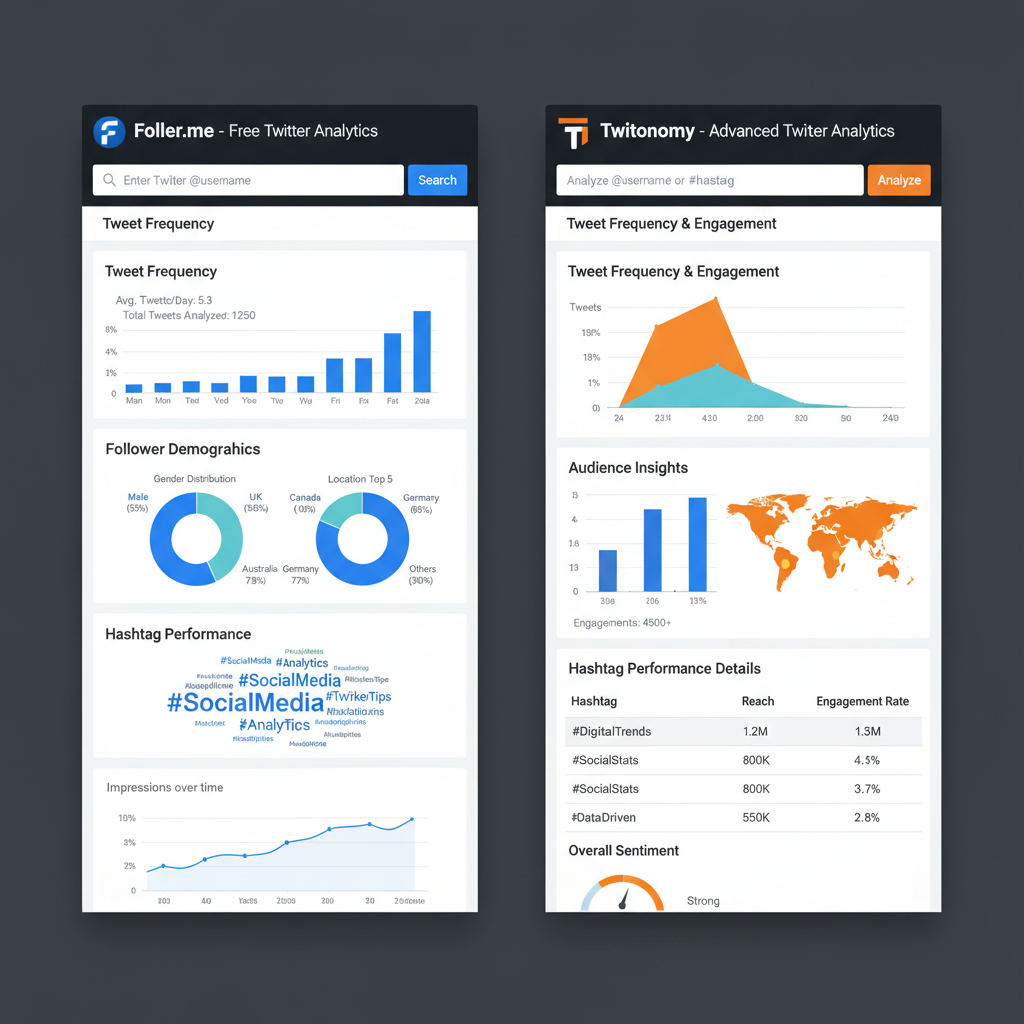Best Twitter Analytics Tools for Audience Growth
Discover top free and paid Twitter analytics tools to track key metrics, boost engagement, and grow your audience strategically.

Best Twitter Analytics Tools for Audience Growth
Growing an engaged audience on Twitter isn’t about posting more—it’s about posting smarter. Twitter analytics tools reveal what content resonates, when your audience is most active, and which conversations you should join. By leveraging the best Twitter analytics solutions, you can transform raw data into strategic actions that drive measurable growth and engagement.

---
Why Twitter Analytics Matter for Growth and Engagement
Twitter analytics help content creators, brands, and marketers understand the impact of each tweet. Instead of guessing what works, analytics provide concrete evidence to guide future posts. This is crucial because:
- Audience Behavior – See when followers are most active.
- Content Performance – Identify tweets that generate the most engagement.
- Campaign Tracking – Measure outcomes from marketing initiatives.
- Return on Investment – Link analytics directly to revenue-generating actions.
Without tracking, efforts are blind. With analytics, you can make informed decisions and scale faster.
---
Core Metrics You Should Track
There are several key metrics every Twitter growth strategy should monitor:
- Followers – The size of your audience over time.
- Impressions – The number of times a tweet was viewed.
- Engagement Rate – Likes, retweets, replies divided by impressions.
- Link Clicks – Number of times users clicked a link in your tweet.
| Metric | Why It Matters | How to Improve |
|---|---|---|
| Followers | Shows audience growth trends | Post regularly, engage with users |
| Impressions | Measures content reach | Use trending hashtags, post at optimal times |
| Engagement Rate | Indicates content resonance | Craft interactive tweets, ask questions |
| Link Clicks | Tracks traffic to external sites | Use strong CTAs, share valuable resources |
---
Native Twitter Analytics Dashboard
Twitter provides its own free analytics tool accessible via desktop:
- Overview Tab – Monthly summary of tweets, impressions, profile visits.
- Tweets Tab – Performance data for individual tweets.
- Audience Insights – Demographics, interests, and location.
- Events and Trends – Opportunities for timely engagement.

This native dashboard is a good starting point, especially for beginners, because it is integrated directly into the platform and offers essential baseline data.
---
Top Free Twitter Analytics Tools
While the native dashboard is useful, there are other free tools with unique features.
1. Twitter Analytics (Native)
Best for: Beginners
Pros: Easy access, official data source
Cons: Limited historical data and advanced filtering
2. Foller.me
Best for: Quick profile analysis
Pros: Shows topics, hashtags, mentions, and tweet frequency
Cons: Less useful for ongoing campaign tracking
3. Twitonomy
Best for: Engagement tracking and export features
Pros: Detailed tweet stats, lists analysis, tweet maps
Cons: Requires manual exports for historical trends
---
Top Paid Twitter Analytics Tools
Paid analytics tools often offer deeper insights, collaboration features, and advanced reporting.
1. Hootsuite
- Strengths: Multi-platform analytics, scheduling, team workflow
- Weaknesses: Higher cost for premium analytics packages
2. Sprout Social
- Strengths: Robust reporting, sentiment tracking, competitive analysis
- Weaknesses: Price point may be high for individuals
3. Brandwatch
- Strengths: AI-driven insights, trend forecasting, powerful search queries
- Weaknesses: Steep learning curve
---
Evaluating Tools: Ease of Use, Data Depth, Reporting Options
When assessing any analytics platform, consider:
- Ease of Use – Can your team quickly navigate and export data?
- Depth of Data – Does it include advanced metrics like sentiment or conversion tracking?
- Reporting Options – Can you customize reports for clients, stakeholders, or team reviews?
---
Aligning Insights with Your Content Strategy
Once collected, analytics should feed directly into content planning:
- Identify Content Types – Visual content may outperform text in certain audiences.
- Timing and Frequency – Schedule posts when engagement potential is highest.
- Topic Focus – Increase coverage of themes with historically high performance.
---
Identify Best-Performing Tweets and Replicate Success
Study top tweets to determine what made them successful:
- Was it the headline style?
- Did it include media (images/videos)?
- Did it tap into trending hashtags or conversations?
By replicating successful tweet attributes, you can produce high-performing content consistently.
---
Tracking Hashtags and Mentions to Expand Reach
Hashtags and mentions are entry points to broader conversations. Using analytics tools, you can:
- Monitor hashtag performance over time.
- Identify which hashtags correlate with higher engagement.
- Track mentions to spark new community interactions.

---
Monitoring Audience Demographics and Trends
Understanding who your audience is will elevate your targeting:
- Location – Post during time zones that align with primary followers.
- Interests – Tailor your tweet topics around shared audience interests.
- Device Usage – Optimize media and links for mobile-heavy audiences.
---
Setting Measurable Goals Using Analytics
Goals provide structure and accountability. Examples:
- Increase Engagement Rate by 15% in 90 days
- Grow Followers by 500 per month
- Achieve 20% more link clicks in Q1
Analytics tools offer baseline measurements from which you can track progress toward these goals.
---
Avoid Vanity Metrics
Vanity metrics (like impressions without engagement) can mislead. Focus on:
- Metrics tied to conversions or meaningful actions
- Engagement depth (comments, shares) rather than surface-level views
- Trends that align with business objectives—such as click-through rates to landing pages
---
Integrating Analytics Reports into Monthly Marketing Reviews
To maximize value:
- Export and compile analytics from chosen tools.
- Compare against the previous month to highlight changes.
- Share insights with the team to inform next month’s strategy.
---
Future Trends in Twitter Analytics
Emerging trends will transform how analytics are used:
- AI Insights – Algorithms predicting tweet performance before publishing
- Predictive Engagement Models – Recommend optimal posting strategies based on historical and industry-wide data
- Real-Time Sentiment Tracking – Automatic monitoring of public response to campaigns
---
Final Thoughts
Twitter analytics aren’t just for large brands—they’re essential for anyone aiming to build a loyal audience, including small businesses, solopreneurs, and community managers. By combining the right free and paid tools, tracking actionable metrics, and integrating insights into your posting schedule, you can turn Twitter into a powerful growth platform.
Key takeaway: Measure, analyze, adjust, and repeat. Doing so transforms your approach from reactive tweeting to strategic engagement for maximum impact.
---
Summary & Next Steps
Unlock the potential of your Twitter presence by investing in the right analytics tools. Whether you choose a free solution like the native dashboard or advanced paid platforms such as Sprout Social or Brandwatch, focus on metrics that drive tangible results. Start tracking your performance today—and turn your tweets into a growth engine.



